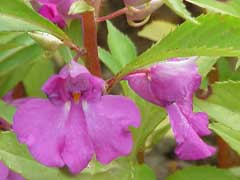 |
|
http://commons.wikimedia.org/wiki/File:Impatiens_balsamina_Blanco2.424-cropped.jpg |
 |
| biolib.de |
Translate this page:
Summary
Bloom Color: Lavender, Pink, Purple, Red, White, Yellow.
Main Bloom Time: Early summer, Early fall, Late summer, Mid summer. Form: Upright or erect.
Physical Characteristics

 Impatiens_balsamina is a ANNUAL growing to 0.6 m (2ft) by 0.5 m (1ft 8in) at a medium rate.
Impatiens_balsamina is a ANNUAL growing to 0.6 m (2ft) by 0.5 m (1ft 8in) at a medium rate.
It is frost tender. The species is hermaphrodite (has both male and female organs) and is pollinated by Insects.
Suitable for: light (sandy), medium (loamy) and heavy (clay) soils and can grow in heavy clay soil. Suitable pH: mildly acid, neutral and basic (mildly alkaline) soils. It can grow in semi-shade (light woodland) or no shade. It prefers moist soil.
UK Hardiness Map
US Hardiness Map
Synonyms
Plant Habitats
Edible Uses
Leaves and young shoots - cooked[177, 179]. Seed - raw or cooked[177]. They are difficult to collect in quantity, mainly because of their exploding seed capsules which scatter the ripe seed at the slightest touch[K].
References More on Edible Uses
Medicinal Uses
Plants For A Future can not take any responsibility for any adverse effects from the use of plants. Always seek advice from a professional before using a plant medicinally.
The plant is cathartic, diuretic and emetic[240]. It is used in the treatment of pains in the joints[240]. The leaf juice is used as a treatment against warts[218]. The flowers are cooling, mucilaginous and tonic[240, 272]. They are useful when applied to burns and scalds[240]. The juice of the flowers is used to treat snakebites[272]. The flowers, and their alcoholic extract, possess marked antibiotic activity against some pathogenic fungi and bacteria[240]. The seed is expectorant and has been used in the treatment of cancer[218]. The powdered seeds are given to women during labour in order to provide strength[272].
References More on Medicinal Uses
The Bookshop: Edible Plant Books
Our Latest books on Perennial Plants For Food Forests and Permaculture Gardens in paperback or digital formats.

Edible Tropical Plants
Food Forest Plants for Hotter Conditions: 250+ Plants For Tropical Food Forests & Permaculture Gardens.
More

Edible Temperate Plants
Plants for Your Food Forest: 500 Plants for Temperate Food Forests & Permaculture Gardens.
More

More Books
PFAF have eight books available in paperback and digital formats. Browse the shop for more information.
Shop Now
Other Uses
A dye is obtained from the flowers and leaves[51, 178, 266]. The prepared juice has been used for dyeing finger and toenails red[4, 266]. The seed contains 27% of a viscous oil, though the report does not mention if this oil is utilised for any purpose[240].
Special Uses
References More on Other Uses
Cultivation details
Landscape Uses:Border, Container, Ground cover, Seashore. Succeeds in any reasonably good soil[1]. Grows well in heavy clay soils. Prefers a moist well-drained humus rich soil in a cool site[200]. Another report says that this species requires warm, moist conditions[260]. Succeeds in sun or semi-shade[188]. Plants are not frost hardy, but can be grown outdoors in Britain by sowing the seed in a greenhouse and planting out after the last expected frosts. A polymorphic species[1], there are several named forms selected for their ornamental value[200]. This plant has seed capsules that spring open forcibly as the seed ripens to eject the seed a considerable distance. The capsules are sensitive to touch even before the seed is ripe, making seed collection difficult but fun[K]. Special Features:Attractive foliage, Extended bloom season in Zones 9A and above.
References Carbon Farming Information and Carbon Sequestration Information
Temperature Converter
Type a value in the Celsius field to convert the value to Fahrenheit:
Fahrenheit:
The PFAF Bookshop
Plants For A Future have a number of books available in paperback and digital form. Book titles include Edible Plants, Edible Perennials, Edible Trees,Edible Shrubs, Woodland Gardening, and Temperate Food Forest Plants. Our new book is Food Forest Plants For Hotter Conditions (Tropical and Sub-Tropical).
Shop Now
Plant Propagation
Seed - sow spring in a greenhouse. When they are large enough to handle, prick the seedlings out into individual pots and plant them out in the summer.
Other Names
If available other names are mentioned here
Native Range
TROPICAL ASIA: India, Myanmar
Weed Potential
Right plant wrong place. We are currently updating this section.
Please note that a plant may be invasive in one area but may not in your area so it's worth checking.
Conservation Status
IUCN Red List of Threatened Plants Status :

Growth: S = slow M = medium F = fast. Soil: L = light (sandy) M = medium H = heavy (clay). pH: A = acid N = neutral B = basic (alkaline). Shade: F = full shade S = semi-shade N = no shade. Moisture: D = dry M = Moist We = wet Wa = water.
Now available:
Food Forest Plants for Mediterranean Conditions
350+ Perennial Plants For Mediterranean and Drier Food Forests and Permaculture Gardens.
[Paperback and eBook]
This is the third in Plants For A Future's series of plant guides for food forests tailored to
specific climate zones. Following volumes on temperate and tropical ecosystems, this book focuses
on species suited to Mediterranean conditions—regions with hot, dry summers and cool, wet winters,
often facing the added challenge of climate change.
Read More
Expert comment
Author
L.
Botanical References
200266
Links / References
For a list of references used on this page please go here
Readers comment
© 2010, Plants For A Future. Plants For A Future is a charitable company limited by guarantee, registered in England and Wales. Charity No. 1057719, Company No. 3204567.